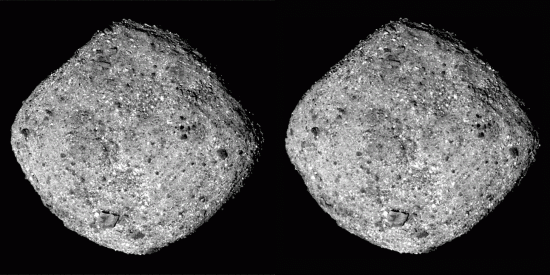
June 5, 2020
Prepare for landing!
NASA launched Osiris-Rex on September 8, 2016 on a mission is to study asteroid 101955 Bennu, Its primary objective is to collect a sample and then return it to Earth. Bennu is among 7000 Near Earth Objects (NEO) that orbit the Sun.
Eventually, NASA will send a manned-mission to a large asteroid, so they are looking at small ones to see if electrical activity will be a problem for astronauts. It is interesting that NASA scientists are concerned about electricity, since it is almost never mentioned in press releases.
Of course, an Electric Universe view of the Solar System presumes energetic events and violent interactions between the planets and moons. As written many times, plasma discharges can excavate surface depressions, scoop out material, and explode it into space, leaving clean, circular depressions with well-defined rims.
So far, the discovery of particle emissions from Bennu is a shock to mission specialists. Many particles are accelerated away from Bennu, which orbit the asteroid before returning to its surface. This observation is reminiscent of data from the EPOXI mission to comet Hartley. At the outset, however, planetary scientists exclude any electrical explanation, because they know almost nothing about the forces involved. “if there’s electricity in space it doesn’t do anything.” It never occurs to them that electricity can create the very things they now struggle to understand.
The shallow craters, along with the sorted boulders, reminiscent of Itokawa, are important considerations in the theory of electrical effects. By thinking only in terms of meteor impacts, landslides and other familiar geological forces, NASA is ignoring the one possibility that makes all the disparate features they see cohesive: an electrically dynamic Solar System in its formative phases, when cosmic thunderbolts carved the surfaces of planets and moons.
Comet Wild 2 is composed of minerals that form only at high temperatures. Anorthite, a compound of calcium, sodium, aluminum and silicate, and diopside, made of calcium, magnesium and silicate were found around Wild 2. The mission team members wondered how something that was supposed to be condensed from a nebular cloud could require a blast furnace to create.
When the first Hayabusa mission finally made it back to Earth, there were more than a thousand fragments inside its collection capsule. The mission team was surprised to find silicates from Itokawa that had been exposed to temperatures in excess of 800 Celsius. Chondritic meteorites are also made of similar stuff. That can only mean that comets, asteroids, and meteoroids share a similar birth.
OSIRIS-REx will briefly touchdown on Bennu, collecting a sample of between 60 and 2000 grams, then returning it to Earth on September 24, 2023. Final analysis of the sample will conclude in 2025. Predictions are that the material will be similar to that already collected by other missions.
Stephen Smith
The Thunderbolts Picture of the Day is generously supported by the Mainwaring Archive Foundation.












